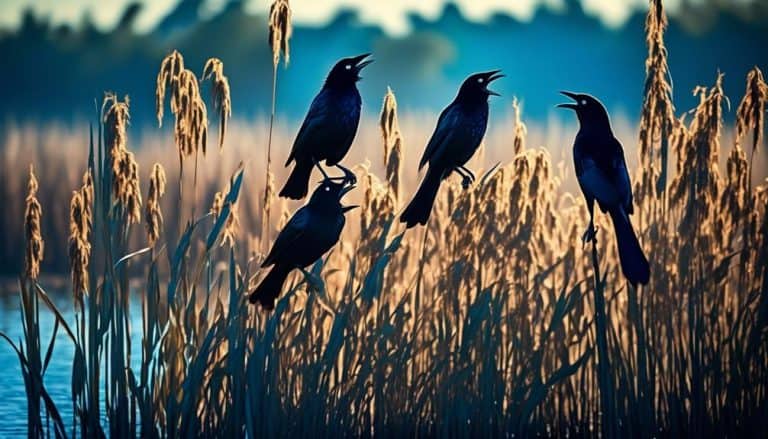As I stroll through the bustling streets of Las Vegas, it's hard not to notice the diverse array of birds that call this city home. From the majestic Red-tailed Hawk soaring above the glittering skyline to the charming Gambel's Quail scurrying through the desert landscape, these common birds have found a way to thrive amidst the urban chaos.
But it's not just the flashy ones that catch my eye; the Great-tailed Grackle's melodic song and the gentle cooing of the Mourning Dove provide a soothing soundtrack to this vibrant city. And let's not forget the Western Kingbird, with its vibrant yellow feathers and agile flight, or the Cactus Wren, perfectly adapted to the arid conditions of the Mojave Desert.
Curious to discover more about the avian inhabitants of this desert oasis? Well, it seems like we're just scratching the surface.
Red-tailed Hawk

As I gazed up at the expansive Las Vegas sky, a majestic Red-tailed Hawk soared gracefully overhead, its distinctive red tail feathers glinting in the sunlight. The Red-tailed Hawk, scientifically known as Buteo jamaicensis, is a prominent bird species found in the Las Vegas ecosystem. This impressive raptor can be found in a variety of habitats, ranging from deserts to grasslands, making it a versatile and adaptable species.
The Red-tailed Hawk is known for its nesting habits, which play a crucial role in maintaining the population of this species. These hawks typically build their nests on high perches, such as tall trees or utility poles. The nests are constructed using sticks and lined with softer materials like grass and leaves. They're usually large and sturdy, providing a safe and secure environment for raising their young.
In terms of its role in the ecosystem, the Red-tailed Hawk is an apex predator, playing a vital part in maintaining the balance of the food chain. These hawks primarily feed on small mammals, such as mice, rats, and rabbits. By controlling the population of these prey species, the Red-tailed Hawk helps regulate their numbers and prevent overpopulation.
Gambel's Quail
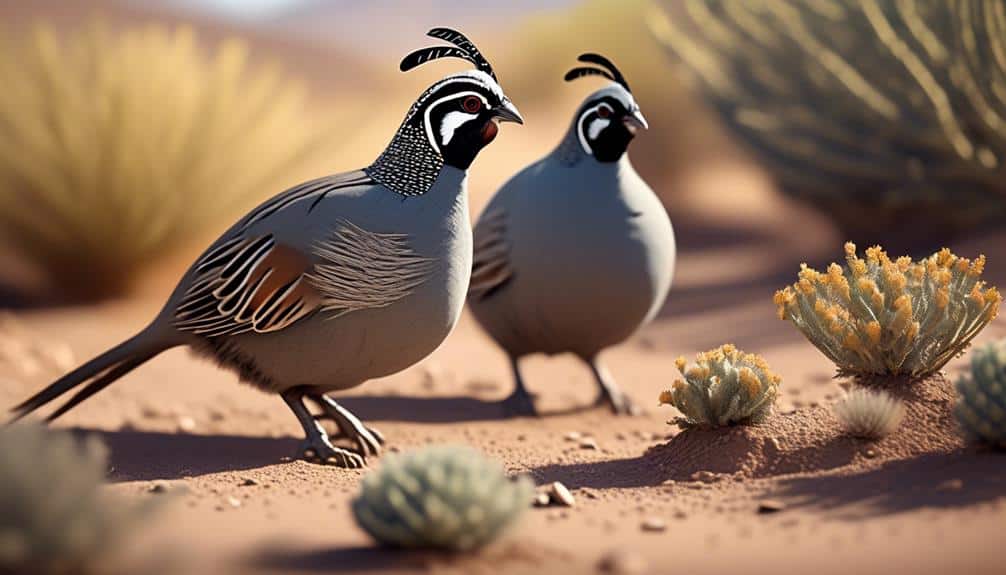
Gazing up at the expansive Las Vegas sky, my attention was drawn to the ground as I spotted a group of Gambel's Quail scurrying among the desert shrubs. These small birds, known for their distinctive topknots and intricate feather patterns, are a common sight in the arid landscapes of Las Vegas.
Here are some fascinating facts about Gambel's Quail:
- Diet: Gambel's Quail are primarily seed eaters. They feed on a variety of desert plants, including grasses, cacti, and wildflowers. They also consume insects and small invertebrates when available.
- Habitat: These quails are well adapted to the desert environment and can be found in a range of habitats, from sandy washes to rocky hillsides. They prefer areas with dense vegetation for cover and nesting, such as desert scrub and mesquite thickets.
- Nesting: Gambel's Quail build their nests on the ground, usually in concealed locations under shrubs or cacti. The nests are shallow depressions lined with grasses and feathers. Female quails lay around 10-12 eggs, which are incubated by both parents.
- Behavior: These birds are highly social and usually travel in coveys, which can consist of up to 30 individuals. They communicate with each other through a variety of calls, including a distinctive 'ka-KAA' sound.
Next time you find yourself exploring the desert landscapes of Las Vegas, keep an eye out for these charming Gambel's Quail as they scurry through the shrubs, adding a touch of life and beauty to the arid surroundings.
Great-tailed Grackle
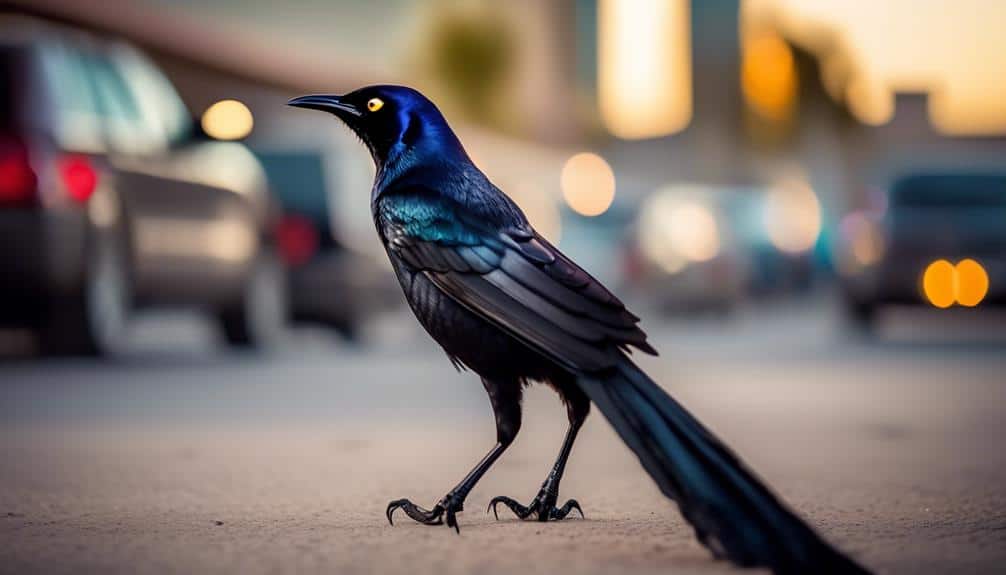
The Great-tailed Grackle, a large and glossy black bird with a long, distinctive tail, is a common sight in the urban areas of Las Vegas. These birds are known for their adaptability and can be found in a variety of habitats, including parks, parking lots, and residential areas. Their behavioral patterns are fascinating to observe.
One interesting behavior of the Great-tailed Grackle is their tendency to form large, noisy flocks. These flocks can consist of hundreds of birds and are often seen congregating in trees or on power lines. The birds communicate with each other using a variety of calls, including a distinctive 'chack' sound.
In terms of habitat preferences, the Great-tailed Grackle is highly adaptable and can thrive in both natural and urban environments. They're commonly found near bodies of water, such as lakes or ponds, where they can forage for food. These birds are opportunistic feeders and will eat a wide variety of items, including insects, fruits, grains, and even garbage.
Mourning Dove

Mourning Doves, with their soft gray plumage and gentle cooing, are a familiar sight in the neighborhoods and open spaces of Las Vegas.
Habitat preferences of mourning doves:
- Mourning doves are adaptable birds that can be found in a variety of habitats, including urban areas, deserts, grasslands, and woodlands.
- They prefer areas with scattered trees or shrubs where they can perch and forage for food.
- Mourning doves are often seen in residential areas, where they find food and water sources provided by humans.
- They're known to roost in trees, bushes, or even on power lines.
Breeding behavior and nesting habits of mourning doves:
- Mourning doves are monogamous and form pair bonds that can last for multiple breeding seasons.
- They build flimsy nests made of twigs, grass, and leaves in trees, shrubs, or sometimes on the ground.
- The female usually lays two eggs, which both parents take turns incubating for about two weeks.
- Once the eggs hatch, the parents continue to care for the young until they fledge, which takes around two weeks.
Western Kingbird
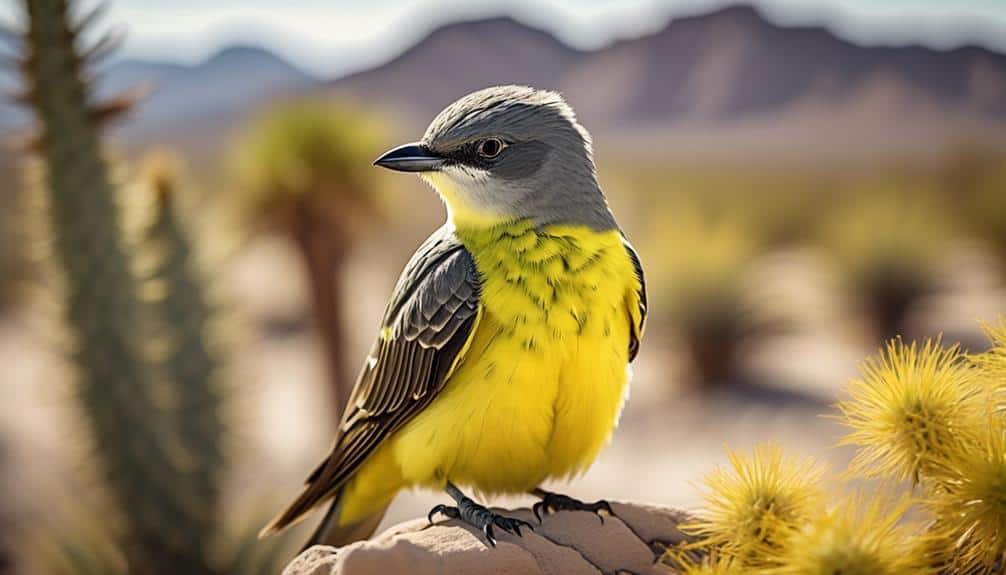
As I observed the diverse avian population of Las Vegas, my attention was drawn to the Western Kingbird, a striking bird with its yellow underparts and gray upperparts. This medium-sized bird is known for its distinctive behavior patterns and interesting diet and habitat preferences.
Behavioral patterns of the Western Kingbird are fascinating to observe. They're highly territorial and will defend their nesting sites vigorously, often engaging in aggressive displays towards intruders. They're also known for their aerial acrobatics, catching insects mid-air with impressive precision. In addition, they've a unique call that consists of a rapid, high-pitched 'ki-ki-ki' sound.
In terms of diet, the Western Kingbird primarily feeds on insects, such as grasshoppers, beetles, and bees. They're skilled hunters, often perching on exposed branches or wires, patiently waiting for their prey. They'll also occasionally consume fruits and berries, especially during the winter months when insects are scarce.
As for habitat preferences, the Western Kingbird is commonly found in open areas with scattered trees, such as grasslands, meadows, and agricultural fields. They prefer nesting in trees or shrubs, building their nests with grass, twigs, and feathers. These adaptable birds can also be found in urban areas, often perching on utility wires or fences.
Cactus Wren
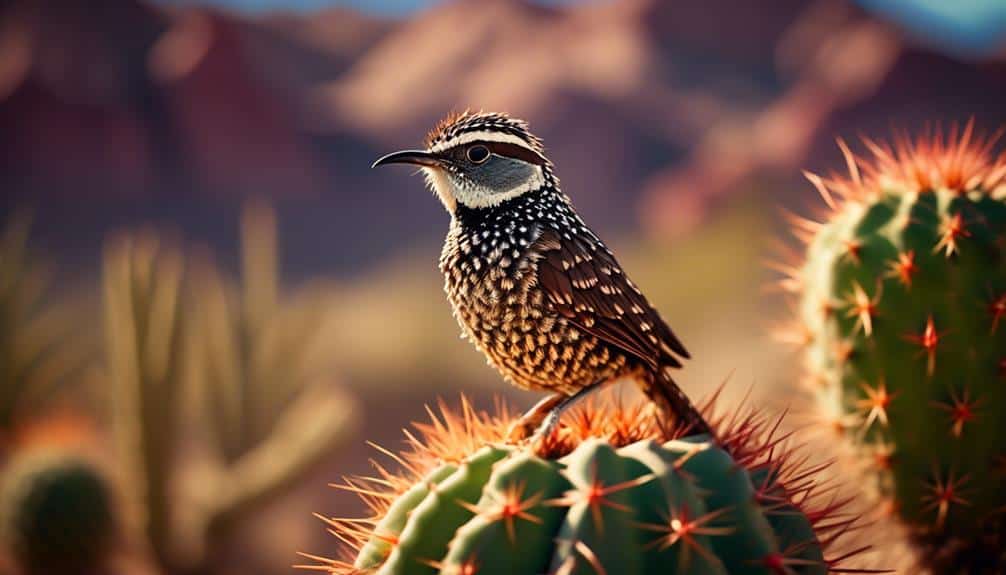
Nestled among the spiny cacti of the desert landscape, the Cactus Wren stands out with its distinctive markings and unique nesting habits. As a bird enthusiast, I've had the privilege of observing these fascinating creatures in their natural habitat. Here are some interesting facts about the Cactus Wren:
- Habitat and nesting habits of the cactus wren:
- The Cactus Wren is primarily found in arid regions, including the deserts of Las Vegas.
- They prefer to build their nests in the protection of cholla or prickly pear cacti.
- These nests are often large and intricate, with multiple entrances and chambers.
- The Cactus Wren uses sticks, grass, and other plant materials to construct its nest.
- Conservation efforts for the cactus wren population in Las Vegas:
- Due to urbanization, the natural habitat of the Cactus Wren is being threatened.
- Conservation organizations are working to protect and preserve the remaining desert areas.
- Efforts include creating protected areas and educating the public about the importance of conserving these birds' habitats.
- Planting native vegetation in urban areas can also provide additional nesting opportunities for the Cactus Wren.
Frequently Asked Questions
What Is the Average Lifespan of a Red-Tailed Hawk?
The average lifespan of a red-tailed hawk is around 10-12 years. However, various factors such as habitat, food availability, and predation can influence their lifespan. It's fascinating to study how these factors impact their survival.
How Many Eggs Does a Gambel's Quail Typically Lay in a Single Clutch?
In my observations of Gambel's quail breeding habits, I've noticed that they typically lay around 10-15 eggs in a single clutch. This is quite remarkable, especially when compared to the nesting behavior of the red-tailed hawk.
What Is the Diet of a Great-Tailed Grackle?
The Great-tailed grackle's diet consists of foraging habits and preferred food sources. They are known to feed on insects, fruits, grains, and even small vertebrates. Their diet varies based on availability and season.
How Far Can a Mourning Dove Migrate During Its Annual Migration?
During its annual migration, a mourning dove can travel impressive distances. It is known to fly as far as 6,000 miles, crossing state lines and even international borders in search of suitable breeding and feeding grounds.
What Is the Distinctive Call of a Cactus Wren?
The distinctive call of a cactus wren is a melodic, warbling sound that echoes through the desert. It stands out among the calls of other desert birds, adding a unique charm to the arid landscape. The cactus wren can be found in its natural habitat, which includes cactus patches and desert shrubs. Its behavior is fascinating to observe, as it builds intricate nests and defends its territory with great determination.
Conclusion
As the sun sets over the vast desert landscape of Las Vegas, the common birds of this city reveal themselves in all their natural beauty.
From the majestic Red-tailed Hawk soaring high above, to the charming Gambel's Quail scurrying through the underbrush, each species brings its own unique presence to this urban oasis.
The melodious songs of the Mourning Dove and the intricate nest-building skills of the Cactus Wren serve as a reminder of the remarkable diversity that thrives amidst the hustle and bustle of this vibrant city.






